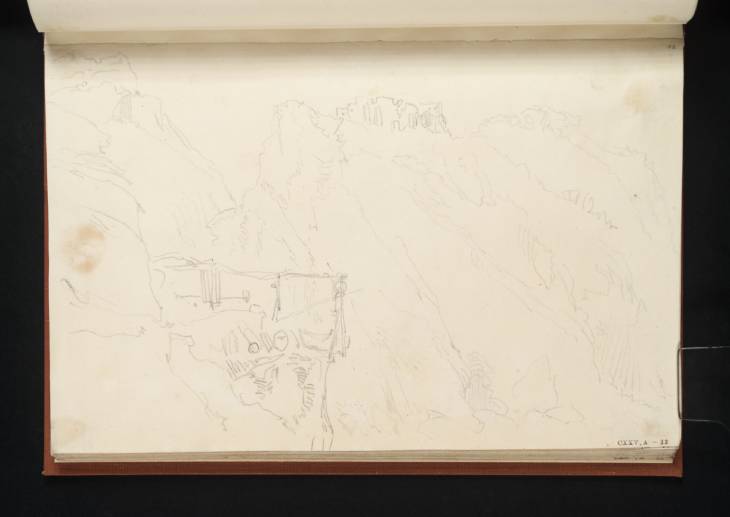Joseph Mallord William Turner Tintagel: The Haven, with Stone-Lifting Gear and the Castle Above 1811
Joseph Mallord William Turner,
Tintagel: The Haven, with Stone-Lifting Gear and the Castle Above
1811
Joseph Mallord William Turner 1775–1851
Folio 32 Recto:
Tintagel: The Haven, with Stone-Lifting Gear and the Castle Above 1811
D41308
Turner Bequest CXXV a 32
Turner Bequest CXXV a 32
Pencil on white wove paper, 140 x 215 mm
Inscribed by C.F. Bell in pencil ‘32’ top right
Blind-stamped with Turner Bequest monogram bottom right
Stamped in black ‘CXXV.A – 32’ bottom right
Inscribed by C.F. Bell in pencil ‘32’ top right
Blind-stamped with Turner Bequest monogram bottom right
Stamped in black ‘CXXV.A – 32’ bottom right
Accepted by the nation as part of the Turner Bequest 1856
Exhibition history
1998
Turner and the Scientists, Tate Gallery, London, March–June 1998 (45, reproduced).
References
1981
Eric Shanes, Turner’s Rivers, Harbours and Coasts, London 1981, p.152.
1998
James Hamilton, Turner and the Scientists, exhibition catalogue, Tate Gallery, London 1998, pp.55, 138 no.45, fig.51, as ‘Tintagel Castle, with Lifting Gear’ from the ‘North Devon sketchbook’.
The view is south-west from the east side of Tintagel Haven, showing two ranges of ruins on the skyline, with the thirteenth-century Cornish castle on the mainland to the top left and remains of what has variously thought to have been originally a Celtic monastery or a Dark Ages settlement1 on the ‘Island’ (actually a peninsula) towards the right. Tintagel is traditionally the place of conception and birthplace of the legendary King Arthur, as Turner could have read in Michael Drayton’s Poly-Olbion, in the comprehensive 1795 Anderson edition of British Poets, which he may have owned as early as 1798.2 In the ‘Illustrations’ (footnotes) to Drayton’s brief references in the ‘First Song’ (first published in 1612), Arthur is noted as having been ‘born in Tintagel castle’.3 In the contemporary Devonshire Coast, No.1 sketchbook (Tate D08595; Turner Bequest CXXIII 119a), Turner labels Glastonbury, where Arthur’s grave was supposedly found in the medieval period, as ‘Avalon’, its Arthurian place name, so he was aware of the story’s regional connections.
In the foreground are a capstan and winch, used to lower slate from nearby quarries to the beach. Rocky, terraced platforms remain visible at this point today. James Hamilton has compared the drawing with an 1870s photograph from a similar viewpoint,4 noting both Turner’s accuracy in recording the machinery and his instinctive exaggeration of the scale and height of the surrounding landscape, ‘while telling the absolute truth about it.’5
Eric Shanes has noted, as did C.F. Bell (see below), that this sketch and those on folios 33 recto and 34 recto (D41309, D41310) are sources for the watercolours Tintagel Castle, Cornwall of about 1815 (Museum of Fine Arts, Boston),6 engraved in 1818 for the Picturesque Views on the Southern Coast of England7 (see the concordance of the series in the 1811 tour introduction), and another of the same subject made in about 1825 (private collection).8 The later watercolour, perhaps ‘an idea for the “Ports [of England]” series,’9 shows a different aspect, without the winching gear in the sketches. The present drawing is closest to the Southern Coast design; D41309 shows a variation, while D41310 shows the winch from the opposite direction. For other views of Tintagel, see under folio 9 recto (D41284).
As discussed in the introduction, the pages of this ‘sketchbook’ appear to have originally been loose sheets, and are not recorded in Finberg’s 1909 Inventory of the Bequest, although he subsequently noted the subject as ‘Rocks, with ruined castle’ in a manuscript listing,10 while C.F. Bell correctly described it in his own notes as ‘Tintagel. See engraving “Southern Coast”’.11 Figures usually corresponding to Finberg’s MS catalogue page numbers, which differ from Bell’s sequence, are inscribed on the verso of most sheets.
Andrew Wilton and Rosalind Mallord Turner, Painting and Poetry: Turner’s ‘Verse Book’ and his Work of 1804–1812, exhibition catalogue, Tate Gallery, London 1990, p.113.
A.J. Finberg, MS addenda, [circa 1928–39], tipped into a copy of his A Complete Inventory of the Drawings of the Turner Bequest, London 1909, Tate Britain Prints and Drawings Room, vol.I, opposite p.356, as CXXV(a) 58.
Technical notes:
The sheet is slightly wrinkled, possibly as a result of exposure to damp. There is abrasion half way down the left-hand edge, apparently caused by the sheet being accidentally stuck to and then separated from another, which seems to seems to have been folio 59 (D41340); the verso of the latter has a corresponding stain and abrasion, and is numbered ‘158 | 57’, indicating its formerly being in sequence with the present sheet, as noted below.
Verso:
Blank, save for inscriptions: inscribed by C.F. Bell in pencil ‘Tintagel (“Southern Coast”)’ bottom left; inscribed by Edwin Fagg in pencil ‘158 | 58’ bottom right. There are glue stains at the corners of the sheet, and a glue-stained repair to a circular area half way down the right-hand edge, reinforcing the abraded recto discussed above.
Matthew Imms
July 2011
How to cite
Matthew Imms, ‘Tintagel: The Haven, with Stone-Lifting Gear and the Castle Above 1811 by Joseph Mallord William Turner’, catalogue entry, July 2011, in David Blayney Brown (ed.), J.M.W. Turner: Sketchbooks, Drawings and Watercolours, Tate Research Publication, December 2012, https://www

